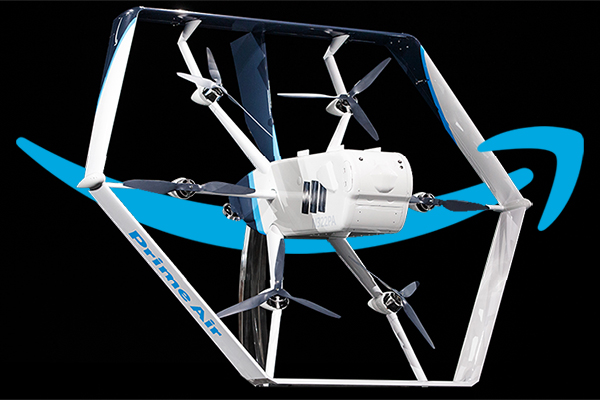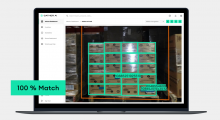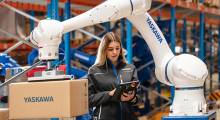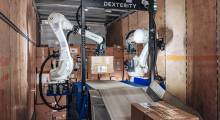Autonomous Drone Technology
When Amazon announced earlier this year that they were evolving their Prime two-day shipping offer in the U.S. to a one-day program, the response was terrific.
But they (Amazon) know customers are always looking for something better, more convenient, and there may be times when one-day delivery may not be the right choice.
Can Amazon Deliver Packages to Customers Even Faster?
They think the answer is yes, and one way they’re pursuing that goal is by pioneering autonomous drone technology.
Today at Amazon’s MARS Conference (Machine Learning, Automation, Robotics, and Space) in Las Vegas, they unveiled their latest Prime Air drone design.
Amazon has been hard at work building fully electric drones that can fly up to 15 miles and deliver packages under five pounds to customers in less than 30 minutes.
And, with the help of their world-class fulfillment and delivery network, Amazon expects to scale Prime Air both quickly and efficiently, delivering packages via drone to customers within months.
Their newest drone design includes advances in efficiency, stability and, most importantly, in safety.
It is also unique, and it advances the state of the art. How so?
First, it’s a hybrid design. It can do vertical takeoffs and landings – like a helicopter.
And it’s efficient and aerodynamic – like an airplane. It also easily transitions between these two modes – from vertical-mode to airplane mode, and back to vertical mode.
It’s fully shrouded for safety. The shrouds are also the wings, which makes it efficient in flight.
The distinctive aircraft is controlled with six degrees of freedom, as opposed to the standard four. This makes it more stable, and capable of operating safely in more gusty wind conditions.
Amazon knows customers will only feel comfortable receiving drone deliveries if they know the system is incredibly safe. So they’re building a drone that isn’t just safe, but independently safe, using the latest artificial intelligence (AI) technologies.
What does that mean? Here’s one way to think about it: Some drones are autonomous but not able to react to the unexpected, relying simply on communications systems for situational awareness.
If Amazon drone’s flight environment changes or the drone‘s mission commands it to come into contact with an object that wasn’t there previously - it will refuse to do so - it is independently safe.
Let's explain by considering two of the drone’s main delivery stages: In transit to a destination, and when approaching the ground.
An Amazon Drone In Transit
Amazon drones need to be able to identify static and moving objects coming from any direction. They employ diverse sensors and advanced algorithms, such as multi-view stereo vision, to detect static objects like a chimney.
To detect moving objects, like a paraglider or helicopter, Amazon uses proprietary computer-vision, and machine learning algorithms.
An Amazon Drone Approaching the Ground
For the drone to descend for delivery, Amazon needs a small area around the delivery location that is clear of people, animals, or obstacles. They determine this using explainable stereo vision in parallel with sophisticated AI algorithms trained to detect people and animals from above.
A customer’s yard may have clotheslines, telephone wires, or electrical wires. Wire detection is one of the hardest challenges for low-altitude flights.
Through the use of computer-vision techniques they’ve invented, Amazon drones can recognize and avoid wires as they descend into, and ascend out of, a customer’s yard.
Amazon is also thrilled about the potential environmental impact.
Prime Air is one of many sustainability initiatives to help achieve Shipment Zero, the company’s vision to make all Amazon shipments net zero carbon, with 50% of all shipments net zero by 2030.
When it comes to emissions and energy efficiency, an electric drone, charged using sustainable means, traveling to drop off a package is a vast improvement over a car on the road.
Today, most of us run to the store because we need an item now. With a service like Prime Air, customers will be able to order from home and stay home. This saves tremendously on fuel usage and reduces emissions.
Amazon drones are safe, efficient, stable, and good for the environment. They know customers have high standards, so Amazon set a high bar for Prime Air.
Amazon is very excited to be nearing their (drone delivery) goal.
About the Author
Jeff Wilke is CEO of Amazon Worldwide Consumer and a 20 year Amazonian.
Related Article: Are Drones A Sky-High Vision For The Future of Logistics?
Related Resources
Using Autonomous Robots to Drive Supply Chain Innovation
This paper details how new technologies are presenting promising opportunities for improvement across the supply chain and how autonomous robots and drones are poised to change the game. Download Now!
Global Autonomous Inventory Robotics New Product Innovation Award
This best practices research paper details the PINC Air inventory robotics solution with its quick deployment model, faster inventory velocity, product ingenuity, and rapid ROI underscoring the decision for PINC to win Frost & Sullivan’s 2017 New Product Innovation Award. Download Now!
The Four Forces Driving Supply Chain Innovation
When supply chain professionals discuss supply chain execution, their focus is typically put on transportation management systems and warehouse management systems, the yard management systems capability and importance is mistakenly undervalued. Download Now!
The Rise of the Digital Yard
In this white paper we explore the rise of the digital yard and show how technology is enabling significant efficiencies, productivity gains, and cost containment in a world where every penny added to the bottom line positively impacts organizational success. Download Now!
Solution Brief: Yard Management System
Yards are the intersection between warehouses and transportation, they are a critical linkage in logistics management practices and have a significant impact on the overall efficiency of the supply chain. Download Now!
More PINC Resources
Latest Drone Delivery News
- Uber Seeks Approval for San Diego Drone Deliveries
- Google Spinoff’s Drone Delivery Business First to Get FAA Approval
Article topics
Email Sign Up


















